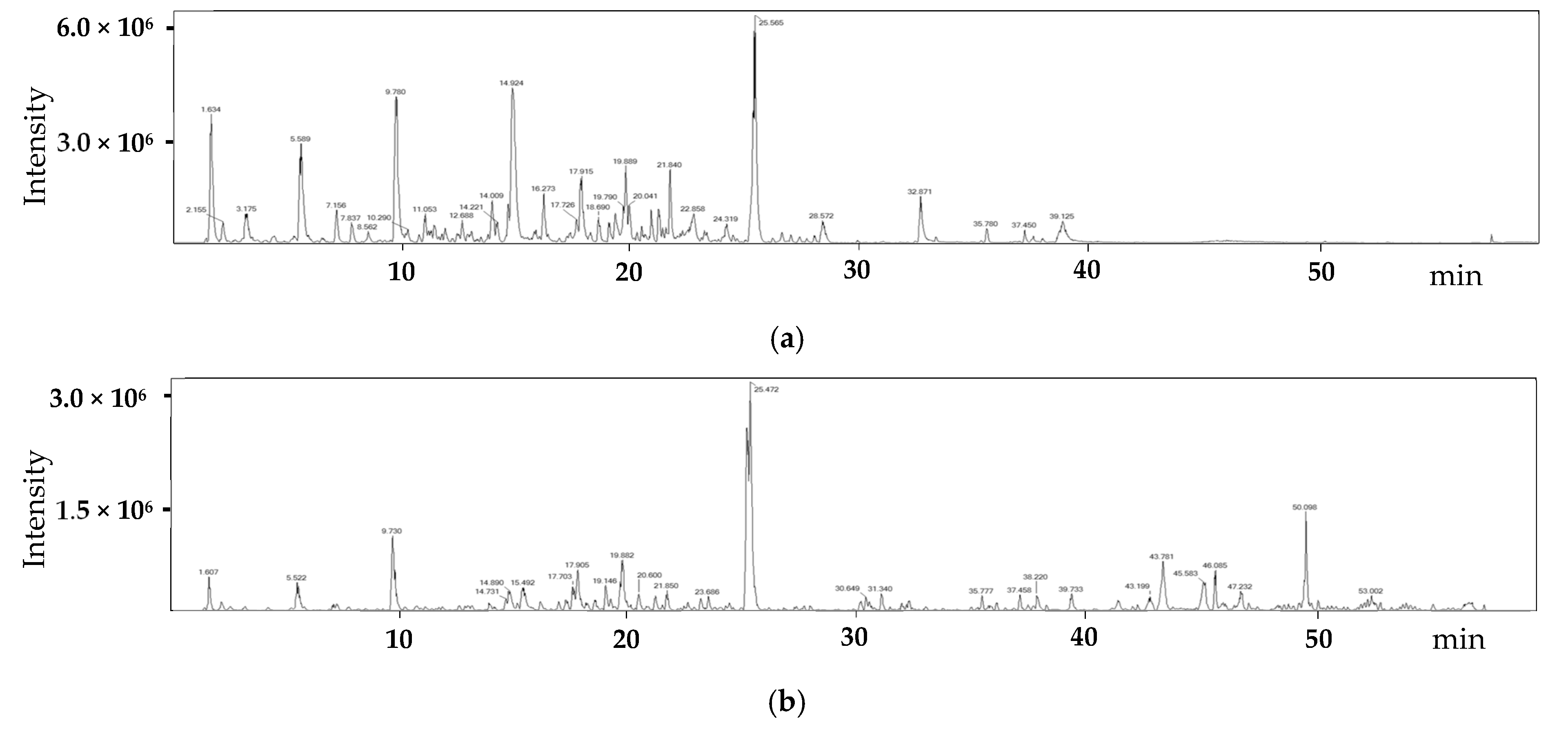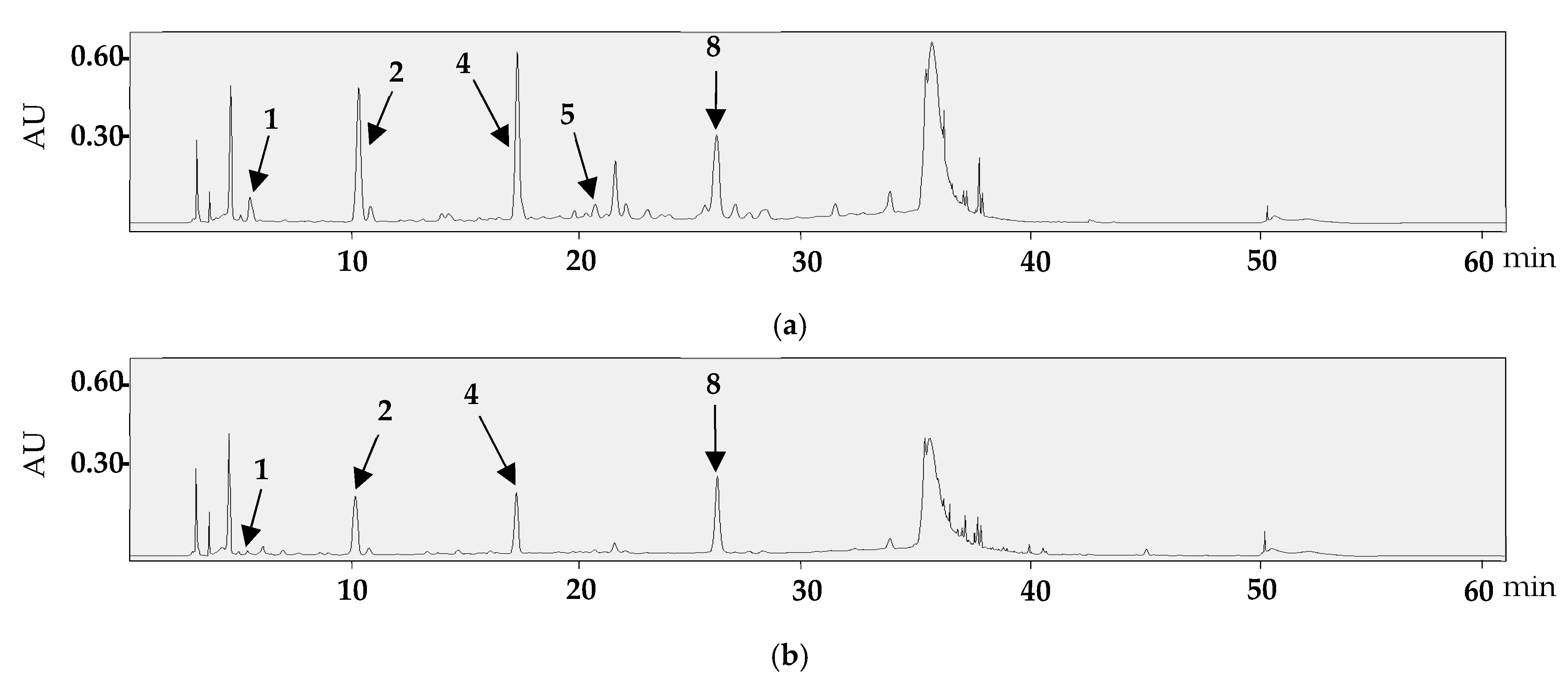Seasonal Variations and Structure-Specific Phytochemical Profiles of Glochidion chodoense
Abstract
1. Introduction
2. Materials and Methods
2.1. Plant Materials
2.2. Instruments and Chemicals
2.3. Extraction of Samples
2.4. Preparation for HPLC/PDA Analysis
2.5. LC-ESI/MS Conditions
2.6. HPLC/PDA Conditions
2.7. Calibration Curve
2.8. Statistical Analysis
3. Results
3.1. LC-ESI/MS Analysis
3.2. HPLC/PDA Analysis
4. Discussion
5. Conclusions
Author Contributions
Funding
Institutional Review Board Statement
Informed Consent Statement
Data Availability Statement
Acknowledgments
Conflicts of Interest
References
- Kim, J.H.; Kim, H.L.; Han, S.H.; Lee, H.; Han, J.E.; Kim, T.S.; Seong, S.H.; Kim, B.R.; Lee, H.N.; Seo, C.; et al. In vitro callus induction and growth for medicinal use of an endangered Korean native plant, Glochidion chodoense C. S. Lee and H. T. Im. Rhizosphere 2024, 29, 100863. [Google Scholar] [CrossRef]
- Chae, H.H.; Kim, Y.C.; Son, S.W. Korean and worldwide research trends on rare plant and endemic plant in Korea. Korean J. Environ. Ecol. 2022, 36, 257–276. [Google Scholar] [CrossRef]
- Sandhya, S.; Chaintanya, R.S.N.A.K.K.; Vinod, K.R.; Rao, K.N.V.; Banji, D.; Sudhakar, K.; Swetha, R. An updated review on the genus Glochidion plant. Arch. Appl. Sci. Res. 2010, 2, 309–322. [Google Scholar]
- Brahma, P.; Baruah, S. Comparative morphological and ethnobotanical assessment of certain taxa of genus Glochidion (Phyllanthaceae) from Assam, India. J. Threat. Taxa. 2023, 15, 24409–24419. [Google Scholar] [CrossRef]
- Xu, Z.; Deng, M. Phyllanthaceae. In Identification and Control of Common Weeds: Volume 2; Xu, Z., Deng, M., Eds.; Springer: Dordrecht, The Netherlands, 2017; pp. 475–486. ISBN 978-94-024-1157-7. [Google Scholar]
- Kato, M.; Takimura, A.; Kawakita, A. An obligate pollination mutualism and reciprocal diversification in the tree genus Glochidion (Euphorbiaceae). Proc. Natl. Acad. Sci. USA 2003, 100, 5264–5267. [Google Scholar] [CrossRef]
- Okamoto, T.; Kawakita, A.; Kato, M. Interspecific variation of floral scent composition in Glochidion and its association with host-specific pollinating seed parasite (Epicephala). J. Chem. Ecol. 2007, 33, 1065–1081. [Google Scholar] [CrossRef]
- Linh, N.N.; Hop, N.Q.; Tuyet, T.; Bich, T.; Son, N.T. Glochidion species: A review on phytochemistry and pharmacology. Nat. Prod. Commun. 2024, 19, 1–30. [Google Scholar] [CrossRef]
- Puapairoj, P.; Naengchomnong, W.; Kijjoa, A.; Pinto, M.M.; Pedro, M.; Nascimento, M.S.; Silva, A.M.; Herz, W. Cytotoxic activity of lupane-type triterpenes from Glochidion sphaerogynum and Glochidion eriocarpum two of which induce apoptosis. Planta Med. 2005, 71, 208–213. [Google Scholar] [CrossRef]
- Thang, T.D.; Kuo, P.C.; Yu, C.S.; Shen, Y.C.; Hoa, L.T.M.; Van Thanh, T.; Kuo, Y.H.; Yang, M.L.; Wu, T.S. Chemical constituents of the leaves of Glochidion obliquum and their bioactivity. Arch. Pharm. Res. 2011, 34, 383–389. [Google Scholar] [CrossRef]
- Wang, Y.; Zhu, H.; Wang, D.; Cheng, R.; Yang, C.; Xu, M.; Zhang, Y. A new phloroglucinol glucoside from the whole plants of Glochidion eriocarpum. Bull. Korean Chem. Soc. 2014, 35, 631–634. [Google Scholar] [CrossRef]
- Velavan, S. Phytochemical techniques-a review. World J. Sci. Res. 2015, 1, 80–91. [Google Scholar]
- Koche, D.; Shirsat, R.; Kawale, M. An overeview of major classes of phytochemicals: Their types and role in disease prevention. Hisiopia 2016, 9, 1–11. [Google Scholar]
- Saxena, M.; Saxena, J.; Nema, R.; Singh, D.; Gupta, A. Phytochemistry of medicinal plants. J. Pharmacogn. Phytochem. 2013, 1, 168–182. [Google Scholar]
- Rhone, M.; Basu, A. Phytochemicals and age-related eye diseases. Nutr. Rev. 2008, 66, 465–472. [Google Scholar] [CrossRef]
- Khan, A. Phytochemicals and their role in curing fatal diseases: A review. Pure Appl. Biol. 2018, 7, 343–354. [Google Scholar] [CrossRef]
- Kawatra, A.; Gupta, S.; Dhankhar, R.; Singh, P.; Gulati, P. Application of phytochemicals in therapeutic, food, flavor, and cosmetic industries. In Phytochemical Genomics; Swamy, M.K., Kumar, A., Eds.; Springer Nature: Singapore, 2022; pp. 85–108. ISBN 978-981-19577-8-9. [Google Scholar]
- Nazir, N.; Koul, S.; Qurishi, M.A.; Taneja, S.C.; Ahmad, S.F.; Bani, S.; Qazi, G.N. Immunomodulatory effect of bergenin and norbergenin against adjuvant-induced arthritis—A flow cytometric study. J. Ethnopharmacol. 2007, 112, 401–405. [Google Scholar] [CrossRef]
- Li, W.; Cai, Z.; Schindler, F.; Bahiraii, S.; Brenner, M.; Heiss, E.H.; Weckwerth, W. Norbergenin prevents LPS-induced inflammatory responses in macrophages through inhibiting NFκB, MAPK and STAT3 activation and blocking metabolic reprogramming. Front. Immunol. 2023, 14, 1117638. [Google Scholar] [CrossRef]
- Salimo, Z.M.; Yakubu, M.N.; da Silva, E.L.; de Almeida, A.C.G.; Chaves, Y.O.; Costa, E.V.; da Silva, F.M.A.; Tavares, J.F.; Monteiro, W.M.; de Melo, G.C.; et al. Chemistry and pharmacology of bergenin or its derivatives: A promising molecule. Biomolecules 2023, 13, 403. [Google Scholar] [CrossRef]
- Zhang, Y.H.; Fang, L.H.; Lee, M.K.; Ku, B.S. In vitro inhibitory effects of bergenin and norbergenin on bovine adrenal tyrosine hydroxylase. Phytother. Res. 2003, 17, 967–969. [Google Scholar] [CrossRef]
- Bajrocharya, G.B. Diversity, pharmacology and synthesis of bergenin and its derivatives: Potential materials for therapeutic usages. Fitoterapia 2015, 101, 133–152. [Google Scholar] [CrossRef]
- Wang, H.; Sui, H.; Ding, Y.; Zhu, B. Stimulation of the production of prostaglandin E2 by ethyl gallate, a natural phenolic compound richly contained in longan. Biomolecules 2018, 8, 91. [Google Scholar] [CrossRef] [PubMed]
- Ooshiro, A.; Hiradate, S.; Kawano, S.; Takushi, T.; Fujii, Y.; Natsume, M.; Abe, H. Identification and activity of ethyl gallate as an antimicrobial compound produced by Geranium carolinianum. Weed Biol. Manag. 2009, 9, 169–172. [Google Scholar] [CrossRef]
- Cui, H.; Yuan, J.; Du, X.; Wang, M.; Yue, L.; Liu, J. Ethyl gallate suppresses proliferation and invasion in human breast cancer cells via Akt-NF-κB signaling. Oncol. Rep. 2015, 33, 1284–1290. [Google Scholar] [CrossRef] [PubMed]
- Lam, K.Y.; Ling, A.P.K.; Koh, R.Y.; Wong, Y.P.; Say, Y.H. A review on medicinal properties of orientin. Adv. Pharmacol. Pharm. Sci. 2016, 1, 1–9. [Google Scholar] [CrossRef]
- Lee, W.; Bae, J.S. Antithrombotic and antiplatelet activities of orientin in vitro and in vivo. J. Funct. Foods 2015, 17, 388–398. [Google Scholar] [CrossRef]
- Baradaran Rahimi, V.; Ghadiri, M.; Ramezani, M.; Askari, V.R. Antiinflammatory and anti-cancer activities of pomegranate and its constituent, ellagic acid: Evidence from cellular, animal, and clinical studies. Phytother. Res. 2020, 34, 685–720. [Google Scholar] [CrossRef]
- Kasai, K.; Yoshimura, M.; Koga, T.; Arii, M.; Kawasaki, S. Effects of oral administration of ellagic acid-rich pomegranate extract on ultraviolet-induced pigmentation in the human skin. J. Nutr. Sci. Vitaminol. 2006, 52, 383–388. [Google Scholar] [CrossRef]
- Ryu, D.H.; Cho, J.Y.; Yang, S.H.; Kim, H.Y. Effects of harvest timing on phytochemical composition in Lamiaceae plants under an environment-controlled system. Antioxidants 2023, 12, 1909. [Google Scholar] [CrossRef]
- Mwamatope, B.; Tembo, D.; Kampira, E.; Mallwichi-Nyirenda, C.; Ndolo, V. Seasonal variation of phytochemicals in four selected medicinal plants. Pharmacogn. Res. 2021, 13, 218–226. [Google Scholar] [CrossRef]
- Kim, K.J.; Park, S.D.; Park, C.H.; Shin, J.H.; Kim, J.C.; Choi, B.S. Changes of root yield and paeoniflorin content affected by harvesting times in peony (Paeonia lactiflora). Korean J. Med. Crop Sci. 2000, 8, 58–63. [Google Scholar]
- Tran, G.H.; Cho, H.; Lee, H.D.; Lee, C.D.; Shim, J.; Ahn, K.H.; Sung, J.S.; Yoo, E.; Lee, S. Analysis of the total polyphenol, flavonoid, and phenolic acid contents in three different leaf types of Lepidium sativum. Nat. Prod. Sci. 2023, 29, 235–241. [Google Scholar] [CrossRef]
- Chen, X.; Li, H.; Zhang, B.; Deng, Z. The synergistic and antagonistic antioxidant interactions of dietary phytochemical combinations. Crit. Rev. Food Sci. Nutr. 2022, 62, 5658–5677. [Google Scholar] [CrossRef] [PubMed]
- Zhang, L.; Virgous, C.; Si, H. Synergistic anti-inflammatory effects and mechanisms of combined phytochemicals. J. Nutr. Biochem. 2019, 69, 19–30. [Google Scholar] [CrossRef] [PubMed]
- Doan, T.T.M.; Tran, G.H.; Ngyuyen, T.K.; Lim, J.H.; Lee, S. Antioxidant activity of different cultivars of Chrysanthemum morifolium and quantitative analysis of phenolic compounds by HPLC/UV. Appl. Biol. Chem. 2024, 67, 17. [Google Scholar] [CrossRef]






| Compound | tR a | Calibration Equation b | R-Value c |
|---|---|---|---|
| 1 | 5.3 | Y = 1844.7 X + 1826.8 | 1 |
| 2 | 10.1 | Y = 7354.2 X − 7391 | 0.9999 |
| 4 | 17.2 | Y = 16054 X − 7949.9 | 0.9999 |
| 5 | 21.1 | Y = 21631 X − 19548 | 0.9996 |
| 8 | 25.7 | Y = 93588 X − 55345 | 1 |
| tR (min) | MW [M−H]− | MW [M+H]+ | Error (ppm) | Elemental Composition | Proposed Compound |
|---|---|---|---|---|---|
| 5.59 | 313.057 | - | 0.2 | C13H14O9 | Norbergenin 1 |
| 5.84 | 305.068 | 307.081 | 0.5 | C15H14O7 | Epigallocatechin 1,2 |
| 9.74 | 327.072 | 329.087 | −0.5 | C14H16O9 | Bergenin 1,2 |
| 14.87 | 197.046 | 199.060 | −0.5 | C9H10O5 | Ethyl gallate 1,2 |
| 17.93 | 447.093 | 449.108 | −0.4 | C21H20O11 | Orientin 1,2 |
| 19.24 | 447.093 | 449.108 | −0.4 | C21H20O11 | Orientin 1,2 |
| 19.43 | 300.999 | - | −0.1 | C14H6O8 | Ellagic acid 1 |
| 19.66 | 441.083 | - | 0.4 | C22H18O10 | Epicatechin gallate 1 |
| 19.77 | 563.141 | 565.155 | 0.0 | C26H28O14 | Isovitexin 2″-O-arabinoside 1,2 |
| 19.89 | 431.098 | 433.113 | 0.1 | C21H20O10 | Isovitexin 1,2 |
| 21.33 | 447.093 | 449.108 | 0.0 | C21H20O11 | Cynaroside 1,2 |
| Time | Content (mg/g Extract) | ||||||||||
|---|---|---|---|---|---|---|---|---|---|---|---|
| 1 | 2 | 3 | 4 | 5 | 6 | 7 | 8 | 9 | Total | ||
| Leaf | May | 10.75 ± 0.18 b | 43.42 ± 0.13 a | ND | 21.75 ± 0.10 b | tr | ND | ND | 2.60 ± 0.03 c | ND | 78.52 |
| July | 3.57 ± 0.19 c | 0.89 ± 0.01 d | ND | 17.48 ± 0.17 c | 0.93 ± 0.01 | ND | ND | 6.39 ± 0.02 a | ND | 29.26 | |
| October | 12.15 ± 0.24 a | 0.49 ± 0.01 e | ND | 22.24 ± 0.12 a | tr | ND | ND | 4.90 ± 0.04 b | ND | 39.78 | |
| Branch | May | ND | ND | ND | ND | tr | ND | ND | ND | ND | - |
| July | ND | 8.56 ± 0.04 c | ND | 2.09 ± 0.01 e | ND | ND | ND | 0.37 ± 0.01 e | ND | 11.02 | |
| October | 1.94 ± 0.06 d | 17.60 ± 0.07 b | ND | 6.70 ± 0.03 d | tr | ND | ND | 1.86 ± 0.01 d | ND | 28.10 | |
Disclaimer/Publisher’s Note: The statements, opinions and data contained in all publications are solely those of the individual author(s) and contributor(s) and not of MDPI and/or the editor(s). MDPI and/or the editor(s) disclaim responsibility for any injury to people or property resulting from any ideas, methods, instructions or products referred to in the content. |
© 2025 by the authors. Licensee MDPI, Basel, Switzerland. This article is an open access article distributed under the terms and conditions of the Creative Commons Attribution (CC BY) license (https://creativecommons.org/licenses/by/4.0/).
Share and Cite
Yoon, N.; Ku, J.; Kang, Y.-H.; Lee, S. Seasonal Variations and Structure-Specific Phytochemical Profiles of Glochidion chodoense. Chemosensors 2025, 13, 116. https://doi.org/10.3390/chemosensors13040116
Yoon N, Ku J, Kang Y-H, Lee S. Seasonal Variations and Structure-Specific Phytochemical Profiles of Glochidion chodoense. Chemosensors. 2025; 13(4):116. https://doi.org/10.3390/chemosensors13040116
Chicago/Turabian StyleYoon, Nari, Jajung Ku, Yang-Ho Kang, and Sanghyun Lee. 2025. "Seasonal Variations and Structure-Specific Phytochemical Profiles of Glochidion chodoense" Chemosensors 13, no. 4: 116. https://doi.org/10.3390/chemosensors13040116
APA StyleYoon, N., Ku, J., Kang, Y.-H., & Lee, S. (2025). Seasonal Variations and Structure-Specific Phytochemical Profiles of Glochidion chodoense. Chemosensors, 13(4), 116. https://doi.org/10.3390/chemosensors13040116






